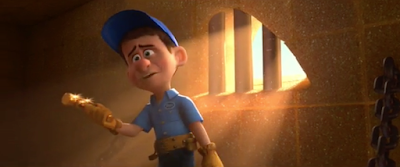Portrayal of Villainy in "Wreck-It Ralph"
I have only seen Wreck-It Ralph once before, a really long time ago, but I remember some great messages about stereotyping villains. I'm excited to see how that comes into play, especially in the scope of this class. Here are my scene-by-scene reactions to portrayal of villainy in the film:
1). "My name is Ralph, and I'm the bad guy." Already, Ralph is defining himself solely by his capacity of good vs. evil.
2). Here's a contrast between the "good guy" and the "bad guy"—clothing, coloring, and body shape all differ.
3). More contrast: Felix (the good guy) has friends, a nice house, and a good life—on the other hand, Ralph is lonely and lives in a dumpster. It's a bit of an exaggeration, but it proves a point.
4). "Sure must be nice being the good guy." Already, this is different from other Disney films—Ralph is a "villain" because he can't control it, not because he doesn't want to. And for once, Disney is following the story of the bad guy instead of the hero.
5). "Us fellow bad guys: we've all felt what you're feeling and we've come to terms with it." Is this acceptance really a motive for most Disney villains, or just the villains portrayed in the video games in this film?
6). Looking at the coloring, shape, and gestures of these "villains," it's easy to see how Disney has employed stereotypes once more—but maybe to prove a point?
7). "You are a bad guy, but that doesn't mean you're a bad guy." This brings up an interesting question: do actions always represent the person behind those actions? Can someone do bad things and still be a good person?
8). Just a general question: if Ralph is so friendly, why doesn't he live with/befriend the other villains? They could make pie and spend time with each other...
9). "We can't change who we are, and the sooner you accept that the better off your game and your life will be." Something tells me Ralph is going to try anyway—he's making an effort to change his innate programming.
10). The "bad guy affirmation" only reaffirms everything the movie has stated so far—and everything that will be questioned later in the film.
11). The security checks always stop the "bad guys." No surprise there.
12). Ralph does good things despite being a "bad person," such as giving fruit to the homeless characters.
13). Ralph's representation on the cake says a lot about his perceived character;
14). "Only good guys win medals, and you sir, are no good guy." More stereotyping. I've noticed in a lot of their newer movies, Disney sets up a ton of stereotypes only to reverse them all later.
15). "Without Ralph, we're doomed." Even though Ralph is bad, he's still necessary for the function and wellbeing of the game. Does this extend into the real world? I'd argue no.
16). Although Fix-It Felix is in direct competition with Ralph, he still isn't portrayed as the true "bad guy", and he has some "good guy" stereotypes: uncanny optimism, popularity and sidekicks, and a potential love interest.
17). Ralph is actually acting like a "bad guy" here, causing havoc and destruction.
18). Nobody in the game refers to Vannelope by her name—they just call her "the glitch." They are still defining the characters by their appearances and not their personalities.
19). "I don't make things, I break things." Even Ralph feels confined by his stereotypes.
20). Even though Vanellope looks like a "good guy," she's considered bad by her fellow game members, and she lives in the same situation as Ralph.
21). I only know King Candy is the real villain because I've seen this movie before, but his portrayal is a lot like the overly feminine villains we discussed in class, complete with a pink (salmon) castle.
22). "You really are a bad guy." Actions vs. intent—Ralph may have destroyed Vanellope's car, but he did it with good intentions. Does that disqualify him from being a villain?
23). Ralph is frustrated with his villainy, and now Felix is frustrated by his ability to only fix things. Anyone can feel trapped by how they are perceived by others.
24). That lime green is back—the color of villainy.
25). Claws, red, purple, contorted face: all signs of villainy.
26). Even when doing the most heroic thing possible, Ralph repeats the bad guy affirmation, once again reasserting that he's still a "villain".
27). The mud puddle Ralph falls into is chocolate, just like the flavoring of his mud on the cake earlier in the movie. Just a small moment of irony.
28). "I don't need a medal to tell me I'm a good guy." Sure enough, stereotypes crushed.
I liked this movie a lot more than I remember—it was plot twisty but still had Disney's old nostalgia. And the message about good guys versus bad guys was much-needed considering Disney's long history of stereotypical villains. King Candy (the real villain) was still very much the typical "Disney bad guy," but this movie was progress. Hopefully, villains of the future will continue to be less cliché.
















Comments
Post a Comment